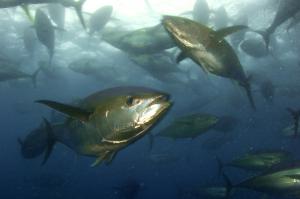New study shows migratory tuna species are spawning in Pacific Marine Protected Area
Skipjack, yellowtail, and bigeye tuna spawned within the borders of the Phoenix Island MPA in Kiribati consistently over the three-year study period.
From 2015 to 2017, SEA and BU conducted expeditions through the protected area to survey tuna larvae in the hope of supporting one of the assumptions that helped established the MPA – that by fully protecting an area in which tuna spawn, pelagic species would have a better chance at success even though they migrate through vast areas of open oceans. Tuna fisheries would then benefit from what is known as the spillover effect, where the offspring of protected fish travel outside the MPAs to supply the fishery with healthy stock. While there is still work to be done to fully test the impact of MPAs on migratory species, the first step is to demonstrate that tuna spawn within the MPA’s borders. The last large-scale tuna larval surveys were widespread across the Pacific from the 1950s to the 1980s and showed that tuna did spawn around the islands, but research since then has been scarce.
“There is a lot of controversy over whether marine protected areas are useful for large and highly migratory animals like tunas, because they move in and out of protected areas. However, protection of adult tunas while spawning can have positive benefits for the population, even if the adults are later caught by fishing gear outside the protected area. Findings from this paper will help to support the Government of Kiribati in their visionary conservation effort to establish, enforce, and monitor the Phoenix Islands Protected Area,” says Dr. Randi Rotjan of BU, a co-author and close collaborator with the Government of Kiribati.
A relatively resource-poor country, Kiribati relies heavily on tuna fishing license revenue from foreign nations to build its Gross Domestic Product (GDP). This revenue can vary between 19% and 93% of its GDP in any given year. Despite this economic pressure, Kiribati holds the prestige of protecting one of the largest sections of ocean of any country. The Phoenix Island Protected Area is 408,250 square kilometers, just under than the size of California, and comprises 11.3% of Kiribati’s total Economic Exclusive Zone (EEZ). Established in 2006 under the United Nations Convention of Biodiversity, PIPA has been protected under Kiribati law since 2008 and in 2015 it was designated as fully protected. These MPAs mean that no extraction or fishing of any kind can be practiced within the area’s borders.
Over the span of three years, the research team sampled tuna larvae (anything younger than 4 weeks old) from both inside and outside the PIPA MPA borders. Along with the sampling locations, the team analyzed ocean currents, expected mortality rates, and larval age to pinpoint the location of the spawning. The data showed that many of the larvae they gathered did come from within the MPA. While their results showed tuna also spawned outside the MPA, the hope is that by creating favorable conditions for tuna within the MPA (plentiful prey, lack of harassment), tuna will spend more time protected within the MPA and spawn more often. PIPA is also uniquely suited to help tuna populations in the future, as warm water from El Niño conditions have pushed tuna further into PIPA, which could mean greater spawning within the protected area as ocean waters heat up.
“This evidence suggests that, if foraging conditions in PIPA are attractive, adult tuna could spend enough time there to benefit from the protection in order to spawn numerous times before becoming vulnerable to fishing again.” writes Christina Hernández, a graduate student at MIT/WHOI in the Llopiz Lab and the study’s lead author. “Our results fit well into the established literature on larval studies in the tropical Pacific, suggesting that spawning in PIPA likely contributes to recruitment in central Pacific tuna stocks.”
A primary concern for governments with MPAs, especially large ones, is the matter of enforcement; with an EEZ of 3.5 million square miles, enforcement of PIPA is expensive and, in the past, Kiribati has only been able to fund a patrol expedition once a year. Starting in 2015, the Waitt Foundation and Oceans 5 partnered with Kiribati and pledged 5 million USD to the PIPA Trust to build capacity within Kiribati to manage and enforce the one of the largest fully protected marine reserves in the Pacific Ocean.
While the behavior of adult tuna is hard to predict from such research, larval studies are a valuable tool to monitor adult presence and broad health indicators without removing adults from the population. This study is the first of many steps in the quest to better understand the effect of MPAs on species with ocean-wide habitats. With support from the Waitt Foundation and Oceans 5, Kiribati aims to lead the way in contributing to ocean science, as it manages one of the largest, deepest, and most diverse protected areas in the world.
Shayna Brody
Waitt Foundation
+1 719-229-5237
email us here
Legal Disclaimer:
EIN Presswire provides this news content "as is" without warranty of any kind. We do not accept any responsibility or liability for the accuracy, content, images, videos, licenses, completeness, legality, or reliability of the information contained in this article. If you have any complaints or copyright issues related to this article, kindly contact the author above.

